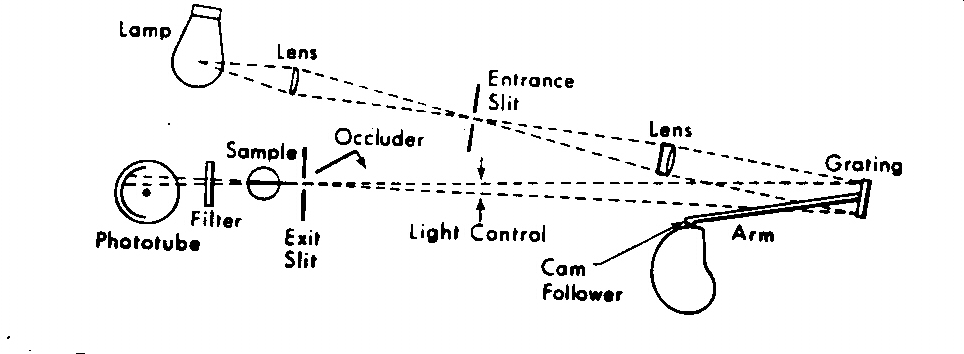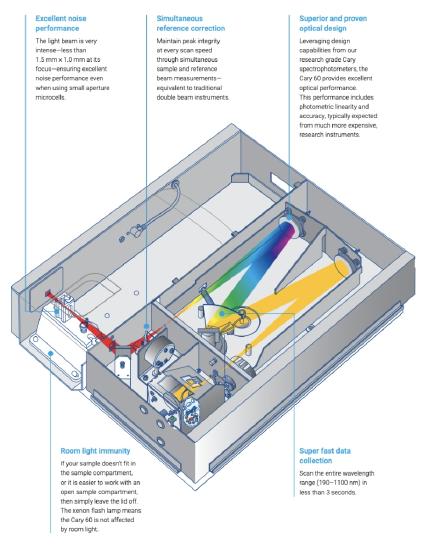8.4.1: Single Beam Instruments for Absorption Spectroscopy - The Spec 20 and the Cary 50
- Page ID
- 342741
All single beam instruments require either separate calibration at a single wavelength or separate recording of base line spectrum for a reference solution that usually only contains the solvent. Single beam instruments are more susceptible to 1//f noice (drift)
The Spectonic 20
The Spectronic 20 is a brand single-beam spectophotometer, designed to operate in the visible region of the spectrum across a wavelength range of 340 nm to 950 nm, with a spectral bandpass of 20 nm. It is designed for quantitative absorption measurement at single wavelengths. Because it measures the transmittance or absorption of visible light through a solution, it is sometimes referred to as a colorimeter.The name of the instrument is a trademark of the manufacturer.
Developed by Bausch and Lomb and launched in 1953, the Spectronic 20 was the first low-cost spectrophotometer (less than $1,000). It rapidly became an industry standard due to its low cost, durability and ease of use, and has been referred to as an "iconic lab spectrophotometer". Approximately 600,000 units were sold over its nearly 60 year production run. It has been the most widely used spectrophotometer worldwide. Production was discontinued in 2011 when it was replaced by the Spectronic 200,but the Spectronic 20 is still in common use. It is sometimes referred to as the "Spec 20" and I have kept 10 working units at Providence (8 with analog meters and 2 with digital readouts).
Pictured in Figure 8.4.1.1 is a vintage Spec 20. The only difference between this vintage instrument and the last version of the Spec 20 is the replacement of the analog meter readout by a digital meter readout.

Figure \(\PageIndex{1}\): A vintage Bausch and Lomb Spec 20 with all controls and display items identified.

Figure \(\PageIndex{2}\): The schematic diagram of a Spec 20.
Pictured in Figure 8.4.1.2 is the schematic diagram for the Spec 20. The optical source in a Spec 20 is a tungsten halogen lamp the intensity of which is controlled by the Power/Zero Control in a manner similar to a common light dimmer. The instrument employs a phototube detector that can be easily changed for work either in the blue or red regions of the visible spectrum. The wavelength selector is a grating the angle of which is controlled by the Wavelgth Control dial attached to the cam follower. Samples are contained in round cuvettes that resemble common test tubes. The light controller is a "V" shaped occluder that blocks a fraction of the light passing through the reference and sample by using the 100% Trans/Light Control knob to insert the occulder more or less into the path of the light beam.
It is best to work with two cuvettes with the spec 20, one containing your solvent and the other your solvent (your reference) and sample. The general procedure to make a a transmittance (0 - 100 %) is as follows.
Step 1. Set the wavelength
Step 2. With nothing in the sample compartment and with the sample compartment closed, adjust the Power/Zero Control knob so that the meter shows 0 % T.
Step 3. With your reference in the sample compartment and with the sample compartment closed, adjust the 100% Trans/Light Control knob so that the meter shows 100 %T.
Repeat steps 2 and 3 as needed for consistency.
Step 4. Insert you sample in the sample compartment, close the lid, and record the % T.
Again, the procedure outlined above needs to be followed each time the wavelength is changed and even if the wavelength is not changed it is good practice to reset the 0 %T and 100% T every 20 minutes of so to account for instrument drift.
The Varian Cary 50 (now Agilent Cary 60)
A single beam instrument that has been a popular choice in research laboratories for the past 20 years is the Varian Cary 50, pictured below in Figure \(\PageIndex{3}\). The Cary 50 is a lower cost instrument that competes well against more expensive double beam instrument for many applications. This instrument has been succeeded by the Agilent Cary 60.

Figure \(\PageIndex{3}\): The Varian Cary 50
The Cary 50 gets all its power from a computer and it an especially versatile instrument with many accessories that are especially useful in biological chemistry laboratories. A picture of the Cary 50 layout is shown in Figure \(\PageIndex{4}\)

Figure \(\PageIndex{4}\): An annotated picture of the Cary 50 optical layout from the sales brochure.
A key feature of the Cary 50 is the Xenon flicker lamp used as the single optical source in this instrument. Unlike tungsten halogen lamps ($50) and the much more expensive deuterium lamps ($600) which have to be replaced every 2000 - 3000 hours, the Xenon flicker lamp last for a very long time (at least the life of the instrument). The lamp flickers on and off at 80 Hz. Consequently, the modulation of the source means that, unlike most absorption instruments, measurements can be made with the sample compartment open to the ambient light in the lab because the detector signal is sampled at the same frequency. In addition and very attractive, the 80 Hz repetition rate of the optical source makes this instrument well suited for kinetic measurements on the millisecond time scale as absorption measurements can be made every 0.0125 s.
The instrument employs two Si photodiode detectors and has a Beer's Law limit of linearity of 3.3 absorbance units.
The internal wavelength selector is based on a Czerny Turner monochromator design covering wavelengths from 190 mnm to 1100 nm and with a fixed spectral bandpass of 1.5 nm. The scan speed for the entire wavelength range can be as fast as 24,000 nm/min so an entire spectrum can be measured in about 3 seconds.

